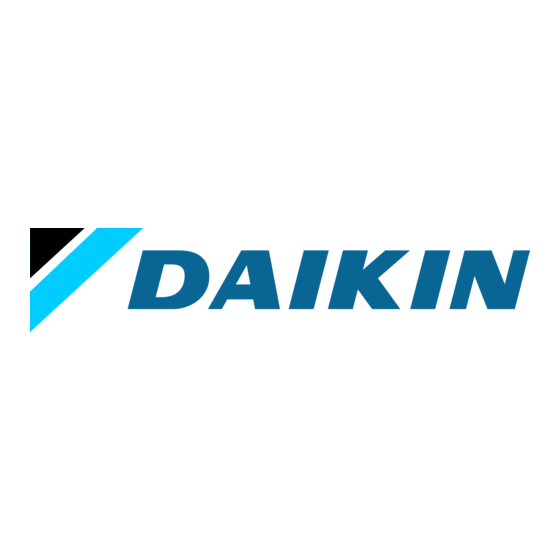
Table of Contents
Advertisement
DAIKIN AIR CONDITIONER
• Read these Safety Precautions carefully to ensure correct installation.
• This manual classifies the precautions into DANGER, WARNING and CAUTION. Be sure to follow all the
precautions below: they are all important for ensuring safety.
DANGER
Indicates an imminently hazardous situation which, if not avoided, will result in death or serious injury.
WARNING
Failure to follow any of WARNING is likely to result in such grave consequences as death or serious injury.
CAUTION
Failure to follow any of CAUTION may in some cases result in grave consequences.
• The following safety symbols are used throughout this manual:
Be sure to observe this instruction.
• After completing installation, test the unit to check for installation errors. Give the user adequate instructions
concerning the use and cleaning of the unit according to the Operation Manual.
DANGER
• Refrigerant gas is heavier than air and replaces oxygen. A massive leak could lead to oxygen depletion, especially in
basements, and an asphyxiation hazard could occur leading to serious injury or death.
• If the refrigerant gas leaks during installation, ventilate the area immediately.
Refrigerant gas may produce a toxic gas if it comes in contact with fire such as from a fan heater, stove or cooking device.
Exposure to this gas could cause severe injury or death.
• After completing the installation work, check that the refrigerant gas does not leak.
Refrigerant gas may produce a toxic gas if it comes in contact with fire such as from a fan heater, stove or cooking device.
Exposure to this gas could cause severe injury or death.
• Do not ground units to water pipes, telephone wires or lightning rods because incomplete grounding could cause a
severe shock hazard resulting in severe injury or death, and to gas pipes because a gas leak could result in an
explosion which could lead to severe injury or death.
• Safely dispose of the packing materials.
Packing materials, such as nails and other metal or wooden parts, may cause stabs or other injuries.
Tear apart and throw away plastic packaging bags so that children will not play with them.
Children playing with plastic bags face the danger of death by suffocation.
• Do not install unit in an area where flammable materials are present due to risk of explosion resulting in serious
injury or death.
• Do not ground units to telephone wires or lightning rods because lightning strikes could cause a severe shock hazard
resulting in severe injury or death, and to gas pipes because a gas leak could result in an explosion which could lead
to severe injury or death.
Safety Precautions (1)
Be sure to establish an earth connection.
3P235796-1F M08B133E
Two-dimensional bar code
is a code for manufacturing.
Never attempt.
Advertisement
Table of Contents

Summarization of Contents
Safety Precautions (1)
Safety Hazard Definitions
Defines DANGER, WARNING, and CAUTION levels with their implications.
Safety Symbols and Post-Install Checks
Explains safety symbols and emphasizes post-installation testing.
Refrigerant Gas Hazards
Details asphyxiation risk from leaks and toxic gas from fire contact.
Safety Precautions (2)
Installation and Electrical Warnings
Covers professional installation, proper parts, base, electrical work, dedicated circuits, and wiring.
Refrigerant Circuit and Grounding Warnings
Addresses refrigerant circuit integrity, pump-down procedures, and grounding safety.
Cautionary Measures
Highlights risks from gas leaks, improper piping, and handling sensitive components.
Precautions for Selecting the Location
Location Selection Criteria
Guide to choosing a suitable installation site based on weight, noise, airflow, and environmental factors.
Low Temperature Operation Caution
Advises on installing the outdoor unit to prevent wind exposure in cold weather.
Outdoor Unit Installation Drawings
Installation Dimensions and Clearances
Illustrates pipe lengths, refrigerant addition, working space, and insulation requirements.
Installation Guidelines
Airflow Clearance Requirements
Specifies minimum clearances around the unit for intake and exhaust airflow based on wall configurations.
Outdoor Unit Installation (1)
Outdoor Unit Placement
Refers to location selection and installation drawings for outdoor unit placement.
Drain Work Procedures
Details the installation of drain socket, receiver, and hose, including cold area considerations.
Outdoor Unit Installation (2)
Pipe Flaring Procedure
Instructions on cutting, preparing, and flaring pipe ends for refrigerant connections.
Refrigerant Piping and Warnings
Covers handling refrigerant piping, oil application, and tightening torque for secure connections.
Outdoor Unit Installation (3)
Purging Air and Leak Checking
Step-by-step guide to removing air and verifying refrigerant gas leakage using a vacuum pump and gauge.
Vacuum Pump Run Time
Specifies required run times for vacuum pumps based on pipe length.
Outdoor Unit Installation (4)
Refrigerant Refilling
Procedures and precautions for refilling refrigerant, emphasizing liquid form.
Pipe Handling and Insulation
Guidance on handling refrigerant pipes and selecting appropriate insulation materials.
Pump Down Operation
Forced Cooling for Pump Down
Steps to initiate forced cooling and close valves for pump down before relocation or disposal.
Wiring (1)
Wiring Warnings and Precautions
Covers safe wiring practices, use of earth leak detectors, and conduit mounting.
Conduit Mounting Method
Illustrates the correct method for mounting electrical conduit.
Wiring (2)
Inter-unit and Power Wiring
Details connecting indoor/outdoor units, power supply wiring, and terminal securement.
Terminal Connection Precautions
Advises on using correct terminals, grounding, and curling wires for secure connections.
Facility Setting Switch
Low Temperature Operation
Explains how to expand the operating range to low outdoor temperatures using a specific switch.
Facility Setting Cautions
Advises on specific precautions when using facility settings, like windbreaks and humidity.
Trial Operation and Testing
Trial Operation Procedure
Guides on performing trial operation in cooling or heating modes and setting temperatures post-operation.
Test Items Checklist
Lists essential checks for installation, refrigerant, wiring, and operation before final sign-off.
















Need help?
Do you have a question about the RKS36 and is the answer not in the manual?
Questions and answers